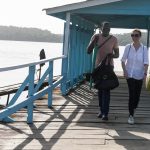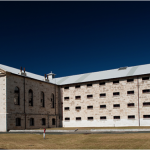
A Global History of Convicts and Penal Colonies: book launch
On July 4th 2018, the eminent scholar of empire, Professor Philippa Levine (University of Texas, Austin), launched my edited volume, A Global History of Convicts and Penal Colonies, at the annual conference of the Australian Historical Association, held at ANU, Canberra. This volume is one of the key outcomes of my ‘Carceral Archipelago’ project. […]

Convicts and the Sea: the naval influence on Gibraltar Convict Establishment
After finishing my PhD at the Carceral Archipelago project in September 2017, I became the Pearsall Fellow in Naval and Maritime History at the Institute of Historical Research. This involved not only a move to London, but a move into a new discipline. As a historian of punishment, I was interested in the way that […]

A Global History of Convicts and Penal Colonies
The main objective of the ‘Carceral Archipelago’ project has been to write the history of convicts and penal colonies into global history, by synthesizing existing research on some geographical contexts with new work on others. My edited volume, A Global History of Convicts and Penal Colonies, published in May 2018 , represents an important […]

The library in the penal colony: Chekhov’s unsung gift to Sakhalin
Chekhov’s contribution to the cultural landscape of the Sakhalin penal colony (1868-1905), the establishment of several school libraries containing more than 2,200 volumes for the island’s children and their convict parents, has received little attention compared with the acclaim accorded his prodigious 1890 demographic census of prisoners. “I visited every settlement and went into every hut,” he wrote.”I don’t […]

Upriver to Mazaruni Prison (Guyana)
One of the wonderful things about ‘blue skies’ research is the element of surprise that it can throw up. When I began work on ‘The Carceral Archipelago’ project, I had not planned to work on the British Caribbean. I had long been aware of early-modern British and Irish convict flows to islands like Barbados, […]

A System of Reintegration and Control: The Dual Functionality of Regional Convict Depots in Western Australia
By Kellie Moss Fremantle Prison, Western Australia (authors own image). The history of convict confinement in Western Australia has been dominated by one towering limestone structure: Fremantle prison. However, convicts were incredibly mobile as they built public works beyond the walls of the prison, and received nominal freedom as probationers and ticket-of-leave holders. […]

Conference Report: Forced Labour, Confinement and Represssion: European, Imperial and Post-Colonial perspectives.
Two weeks ago, a joint workshop on ‘Forced labour, confinement and repression: European, Imperial and Post-Colonial Perspectives’ was hosted by The Carceral Archipelago project and The Stanley Burton Centre for Genocide and Holocaust Studies, both at the University of Leicester. Our aim was to bring into dialogue practices of coercion, confinement and forced labour […]

The “Pains of Imprisonment”: an historical sociology of penal transportation?
A few years ago, the eminent scholar of the Russian Gulag, Professor Judith Pallot, challenged me to consider the relevance of the sociology of incarceration as a means of understanding convict experiences in penal colonies. She advised me to think in particular about Gresham M. Sykes’ classic 1958 text, The Society of Captives: A […]

A Snapshot of Collaborative Work in History
During my PhD study and for the first ten years of my academic career, I researched alone. I went to the archives, I discussed and presented my work to academic audiences, and I published books and academic papers. Though like many others, I felt myself to be engaged in a larger intellectual project (subaltern studies, […]

In my prison notebook
Last year I came across a rare archival find: multiple editions of a 19th century prison newspaper covertly produced by Russian inmates between 1890 and 1905. The newspaper editions, now brittle paper manuscripts fraying brown along their edges, were archived along with a note of introduction by the editor-in-chief. The editor describes the way in […]

Recent Comments